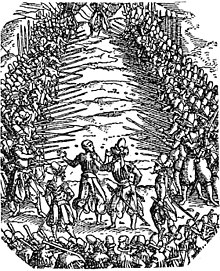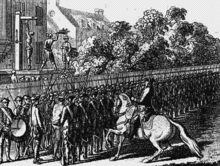Run the gantlet

Gauntlet (also Spitzruten- or alleys running called) refers to a military corporal punishment , which until the 19th century because of more or less serious crimes by war or state court was imposed on ordinary soldiers.
Military punishment


The gauntlet is probably due to the "right of the long skewers " or the lance Court of mercenaries back. If there were dishonorable or particularly serious crimes that stained the honor of the entire Landsknechtsfähnlein or regiment , the Profoss or Provost appeared as public prosecutor and the Landsknechtsgemeinde as judge. The Landsknechtsgemeinde (Landsknechtsgemeinde) defined three groups that recommended a judgment independently of one another: acquittal , pardon, or death sentence . While the profoss was justifying the death sentence, the defendant could plead his innocence or plead for mercy. If the mercenaries advocated the death sentence, they went to the place of execution and formed a lane there in an east-west direction, on the sides of which the spear bearers lined up in two tightly closed rows of three. If a gauntlet left a gap in order to let the death row inmate escape, he threatened to have to run through the alley in place of the delinquent. At the end of the alley stood the ensigns with the lowered, dishonored flags . The condemned man had to confess to his comrades that he pardoned their judgment. The "poor man", accompanied by Profoss, walked through the alley three times to say goodbye to his comrades and to beg their pardon for his outrage, then the ensigns rolled up the flags and pushed them back into the ground, Profoss struck him Sinner on the shoulder three times, the doomed walked into the alley and marched towards the flags. The judge and executioner in this case were the mercenaries themselves, who punished the disgrace with the stabbing spear and thus restored the honor of the flag.
In the age of absolutism, running the gauntlet became an integral part of disciplinary power. Under the supervision of officers, one or several hundred soldiers with their rifles in front of them formed an alley about two meters wide, which the condemned man, bared up to the belt, had to walk slowly several times with his hands tied to his chest while drumming. Here he received a blow on the back from every soldier with a hazel or willow rod (spit or pointed rod). The Prussian cavalry used stirrup leathers instead of rods until 1752 . In order to prevent the condemned from walking fast, a non-commissioned officer stepped ahead, holding the point of a saber in front of his chest.
Running the gauntlet six times by 300 men on three days with one day rolling over each time was equal to the death penalty and usually resulted in death. If the convict could no longer walk, he was placed on straw and then received the specified number of pranks. To “bite through the pain”, the convict held a lead ball between his teeth while running the gauntlet.
The high personnel costs associated with this punishment ceremony can be explained by the intended deterrent effect on the assembled soldiers. In contrast to stunting , running the gauntlet was not viewed as a dishonorable punishment , as Daniel Chodowiecki's well-known copper engraving, The honest street running, and the dishonest stunting for Johann Bernhard Basedow's elementary work shows.
This extremely harsh punishment was abolished in Prussia in 1806, in Württemberg in 1818, in Austria in 1855 and in Russia in 1863. Similar punishments were used by the Romans ; see Fustuarium .
In the seafaring of the 18th and 19th centuries, running the gauntlet ( running through the daggers in a nautical manner , with ropes instead of rods) and keeling were the most severe of all corporal punishments . For less serious crimes, driving / falling from the yard was intended , especially in the Netherlands .
Figurative sense
Today, “running the gauntlet” in a figurative sense is a situation in which someone in a row experiences strong opposition and harassment from several people (rarely also institutions, e.g. authorities) for a common reason. The speaker does not judge the reason as justified or unjustified. The expression is mostly applied to situations that in the broadest sense still contain a movement (a “run”), such as passing a crowd of loud critics or going to several authorities; However, it is also used less often for cases where there is no movement, such as unpleasant meetings in a company or political discussions.
literature
- Running the gauntlet . In: Meyers Konversations-Lexikon . 4th edition. Volume 15, Verlag des Bibliographisches Institut, Leipzig / Vienna 1885–1892, p. 145.
- Georg Liebe: Soldier and weapons trade . 2nd reprint edition. Photo-mechanical reprint of the Leipzig 1899 edition. Diederichs, Düsseldorf et al. 1976.
- Douglas Miller, John Richards: Landsknechte. 1486-1560 . Siegler, St. Augustin 2004, ISBN 3-87748-636-3 .
Depiction in feature films
- The men in the death hill (GDR) / The hopeless (West Germany) (original title Szegénylegények ; Miklós Jancsó , Hungary 1966)
- Barry Lyndon ( Stanley Kubrick , Great Britain 1975)
- Trenck - Two hearts against the crown ( ZDF television multi-part, Gernot Roll , Germany 2003)